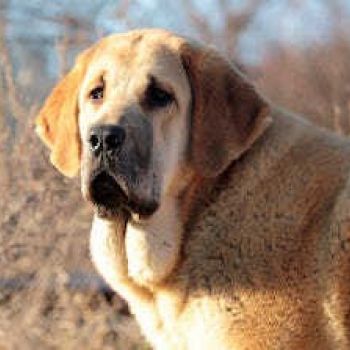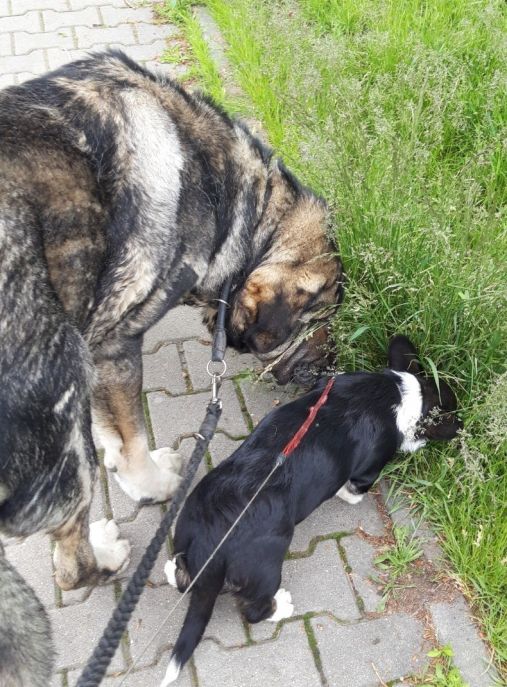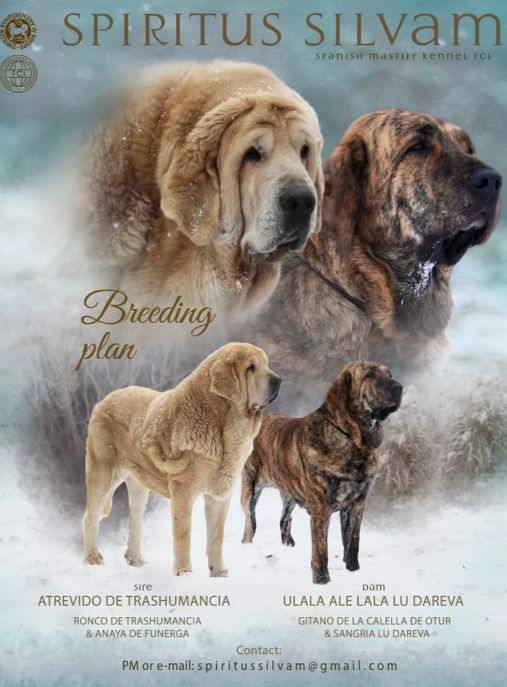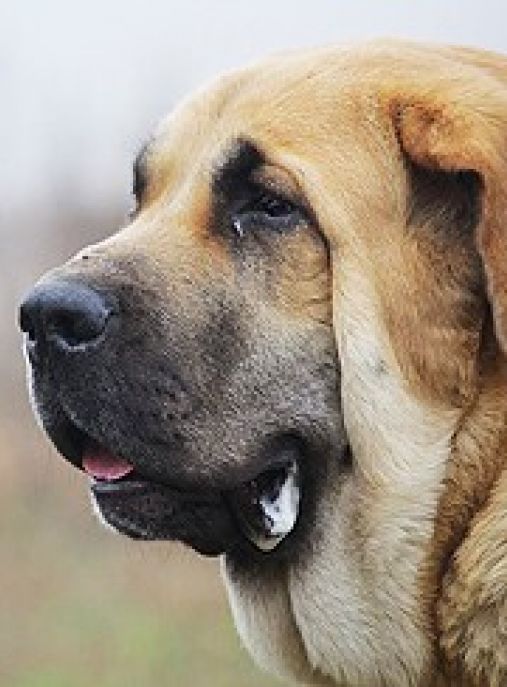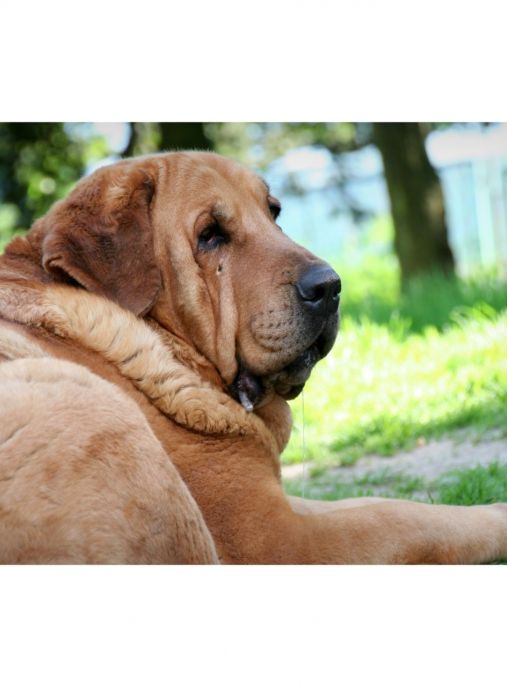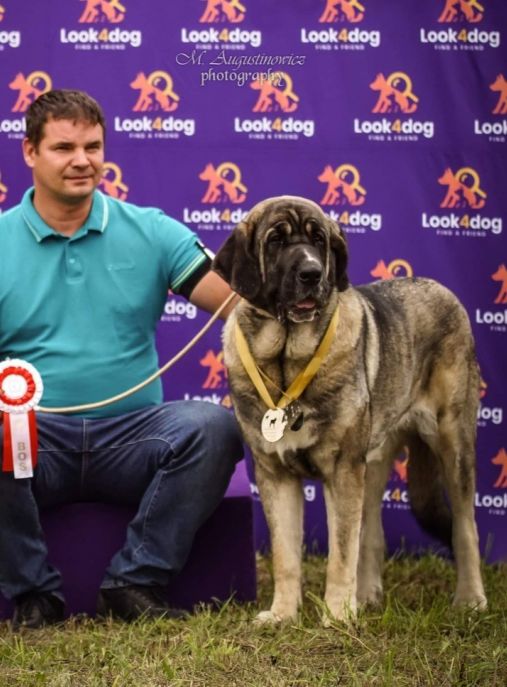The Spanish Mastiff, also known as Mastín Español, is a majestic and powerful dog breed that hails from Spain. Renowned for its imposing size and protective nature, this breed has a long history of guarding livestock and properties. With its noble appearance and unwavering loyalty, the Spanish Mastiff has become a beloved companion and guardian for many families.
The history of the Spanish Mastiff can be traced back to ancient times, where it was believed to have descended from the ancient Molosser dogs. These dogs were brought to the Iberian Peninsula by Phoenician traders and later crossed with local breeds, resulting in the development of the Spanish Mastiff we know today.
According to the FCI (Fédération Cynologique Internationale) typology, the Spanish Mastiff belongs to Group 2, Section 2.2 - Molossoid breeds. This group includes large and powerful dogs that were historically used for guarding and protecting livestock. The Spanish Mastiff shares this classification with other notable breeds such as the English Mastiff, Neapolitan Mastiff, and Tibetan Mastiff.
The Spanish Mastiff is primarily bred for its guarding abilities and is commonly used to protect livestock, particularly sheep and goats. Its natural instinct to protect and its imposing size make it an excellent deterrent against predators such as wolves and bears. Additionally, its calm and gentle demeanor allows it to be a loving and loyal family companion.
In terms of physical characteristics, the Spanish Mastiff is a large and robust breed. Males typically weigh between 150 to 220 pounds (68 to 100 kg), while females range from 120 to 180 pounds (54 to 82 kg). Their height at the shoulder can vary between 28 to 35 inches (70 to 90 cm). These measurements make the Spanish Mastiff one of the largest dog breeds in the world.
The breed's coat is dense, thick, and weather-resistant, providing protection against harsh climates. The coat comes in various colors, including fawn, brindle, black, and wolf-gray. The Spanish Mastiff's face is adorned with expressive almond-shaped eyes and pendant ears that hang close to the head.
The Spanish Mastiff has an average life expectancy of 10 to 12 years. However, with proper care, nutrition, and regular exercise, some individuals have been known to live even longer. Like many large breeds, the Spanish Mastiff is prone to certain health issues, including hip dysplasia, elbow dysplasia, and bloat. Regular veterinary check-ups and a balanced diet are essential to ensure their overall well-being.
Despite its imposing size, the Spanish Mastiff is known for its gentle and calm temperament. It is inherently protective of its family and territory, making it an excellent watchdog. However, early socialization and training are crucial to ensure that the breed develops into a well-rounded and obedient companion.
One interesting fact about the Spanish Mastiff is its incredible strength. It has been reported that a single Spanish Mastiff can successfully fend off a wolf or bear, protecting the livestock under its care. This strength, combined with its intelligence and loyalty, has made the breed highly valued by shepherds and farmers throughout history.
In conclusion, the Spanish Mastiff is a remarkable breed with a rich history and impressive physical attributes. Its role as a guardian and protector of livestock has solidified its place as a cherished working dog. With its gentle nature and unwavering loyalty, the Spanish Mastiff has also found a special place in the hearts of families seeking a devoted and protective companion.
The Spanish Mastiff, also known as the Mastín Español, is a majestic and powerful breed that possesses a unique character. With a history dating back thousands of years, these dogs have been bred for their exceptional guarding and herding abilities. Their character is a blend of loyalty, intelligence, and independence, making them a remarkable companion and guardian.
One of the most striking aspects of the Spanish Mastiff's character is their unwavering loyalty. They form deep bonds with their family and are incredibly protective of them. This loyalty extends to their territory, which they guard with great dedication. Their imposing size and deep bark act as a deterrent to potential intruders, making them an excellent choice for guarding properties and livestock.
Despite their imposing appearance, Spanish Mastiffs are gentle giants. They are known for their calm and patient nature, especially when interacting with children. They have a natural instinct to protect and care for their family members, making them an ideal choice for families with young children. However, due to their large size, it is important to supervise interactions between the dog and children to ensure everyone's safety.
Spanish Mastiffs are intelligent dogs, but they also possess an independent streak. This independence can make training a challenge, as they may be less inclined to follow commands blindly. However, with consistent and patient training methods, they can be taught to be obedient and well-behaved. Early socialization is crucial to ensure they grow up to be well-rounded dogs. Exposing them to various people, animals, and environments from a young age will help them develop into confident and well-adjusted adults.
When it comes to exercise, Spanish Mastiffs have moderate energy levels. They are not overly active dogs and are content with a daily walk or playtime in a securely fenced yard. However, it is important to note that they are prone to obesity, so regular exercise and a balanced diet are essential to maintain their overall health and well-being.
Proper care and grooming are also important for Spanish Mastiffs. Their dense double coat requires regular brushing to prevent matting and to keep shedding under control. Additionally, their ears should be checked regularly for any signs of infection, and their nails should be trimmed regularly to avoid overgrowth.
In conclusion, the Spanish Mastiff is a remarkable breed with a unique character. Their loyalty, intelligence, and independence make them excellent guardians and companions. While they may require consistent training and socialization, their gentle nature and love for their family make them a wonderful addition to any household. With proper care, training, and socialization, the Spanish Mastiff can thrive and bring joy to their owners for many years to come.
The Spanish Mastiff, also known as Mastín Español, is a majestic and powerful breed that requires specific care to ensure their well-being and happiness. These dogs have a rich history as livestock guardians in Spain and possess a calm and gentle nature. If you are considering bringing a Spanish Mastiff into your home, here are some essential tips on how to care for them properly.
First and foremost, Spanish Mastiffs are large dogs that require ample space to move around comfortably. They are not well-suited for apartment living and thrive in homes with large yards or rural areas where they can roam freely. Providing them with a secure and spacious outdoor area is crucial to their physical and mental stimulation.
Exercise is vital for Spanish Mastiffs to maintain a healthy weight and prevent boredom. Daily walks and playtime are essential, but it's important to avoid excessive exercise, especially during their growth stages. Their bones and joints are still developing, so high-impact activities like jumping or running on hard surfaces should be limited to prevent potential injuries.
Grooming is relatively low-maintenance for Spanish Mastiffs. Their dense double coat protects them from harsh weather conditions, so regular brushing is sufficient to keep their coat healthy and free of tangles. However, during shedding seasons, which occur twice a year, more frequent brushing is necessary to remove loose hair and prevent matting.
Spanish Mastiffs are prone to certain health issues, including hip dysplasia, elbow dysplasia, and bloat. Regular veterinary check-ups are crucial to monitor their overall health and catch any potential problems early on. Additionally, a balanced diet tailored to their specific needs is essential to maintain their optimal weight and prevent obesity, which can exacerbate joint issues.
Socialization is key for Spanish Mastiffs from an early age. These dogs have a natural instinct to protect their family and territory, which can sometimes lead to overprotective behavior if not properly socialized. Expose them to various people, animals, and environments to ensure they grow up to be well-rounded and confident dogs.
Training should be approached with patience and consistency. Spanish Mastiffs are intelligent but can be independent and stubborn at times. Positive reinforcement techniques, such as rewards and praise, work best with this breed. Early obedience training and socialization will help establish boundaries and ensure they grow into well-behaved adult dogs.
It's important to note that Spanish Mastiffs are not suitable for first-time dog owners or those seeking a highly obedient breed. They require experienced owners who can provide strong leadership and establish themselves as the pack leader. Harsh training methods or physical punishment should never be used, as it can damage the trust and bond between you and your dog.
Lastly, it's crucial to provide your Spanish Mastiff with plenty of love, attention, and mental stimulation. They are loyal and devoted companions who thrive on human interaction. Regular playtime, puzzle toys, and interactive games will keep their minds engaged and prevent boredom, which can lead to destructive behavior.
In summary, caring for a Spanish Mastiff involves providing them with ample space, regular exercise, proper grooming, and a balanced diet. Socialization, training, and regular veterinary check-ups are essential for their overall well-being. With the right care and attention, your Spanish Mastiff will be a loyal and loving companion for many years to come.
The Spanish Mastiff, known for its imposing size and noble demeanor, is a breed that possesses a wide range of coat colors. However, the most common and traditional color seen in Spanish Mastiffs is a rich and earthy hue known as fawn.
The fawn color of the Spanish Mastiff's coat is characterized by a warm and deep shade that resembles the color of ripe wheat fields in the late summer sun. It is a color that exudes strength and resilience, perfectly complementing the breed's robust physique. The fawn coat of the Spanish Mastiff is often described as being solid and uniform, without any markings or patterns.
The fawn coloration of the Spanish Mastiff's coat can vary in intensity, ranging from a lighter, sandy tone to a darker, reddish-brown shade. This variation adds depth and dimension to the dog's appearance, enhancing its regal and majestic presence. The coat is typically dense and thick, providing protection against harsh weather conditions and potential predators.
One of the most striking features of the fawn coat is its ability to reflect light, creating a beautiful sheen that enhances the dog's overall appearance. When the Spanish Mastiff is bathed in sunlight, its coat radiates a warm and golden glow, accentuating its muscular build and giving it an almost ethereal aura.
The fawn color of the Spanish Mastiff's coat is not only visually appealing but also serves a practical purpose. It allows the dog to blend seamlessly with its natural surroundings, making it an excellent guardian and protector of livestock. This camouflage-like quality enables the Spanish Mastiff to remain inconspicuous while keeping a watchful eye over its charges, ensuring their safety and well-being.
In addition to the fawn color, Spanish Mastiffs can also exhibit other coat colors such as brindle, black, and gray. However, it is the fawn color that is most commonly associated with this magnificent breed. It is a color that symbolizes strength, loyalty, and resilience, perfectly encapsulating the essence of the Spanish Mastiff.
In conclusion, the fawn color of the Spanish Mastiff's coat is a captivating and distinctive feature of this remarkable breed. Its warm and earthy tones, combined with its reflective sheen, create a visually stunning appearance that is both regal and powerful. Whether standing proudly in a show ring or patrolling the countryside, the fawn coat of the Spanish Mastiff is a testament to its rich heritage and unwavering dedication.
The Spanish Mastiff, also known as Mastín Español, is a majestic and powerful breed that originated in Spain. These dogs have a robust and sturdy build, with a strong bone structure and a thick double coat that provides protection in various weather conditions. While they are generally healthy dogs, like any other breed, they are prone to certain health issues that owners should be aware of to ensure their well-being.
One of the most common health concerns in Spanish Mastiffs is hip dysplasia. This condition occurs when the hip joint doesn't develop properly, leading to discomfort, pain, and eventually arthritis. Responsible breeders will perform hip evaluations on their breeding dogs to reduce the risk of passing on this condition. Regular exercise, a balanced diet, and maintaining a healthy weight can also help minimize the impact of hip dysplasia.
Another health issue that can affect Spanish Mastiffs is gastric torsion, also known as bloat. This condition occurs when the stomach fills with gas and twists, leading to a potentially life-threatening situation. To prevent bloat, it is recommended to feed Spanish Mastiffs smaller meals throughout the day instead of one large meal. Avoiding vigorous exercise immediately after eating and using elevated food bowls can also help reduce the risk.
Spanish Mastiffs are prone to certain eye problems, including entropion and ectropion. Entropion is a condition where the eyelid rolls inward, causing the eyelashes to rub against the cornea, leading to irritation and potential damage. Ectropion, on the other hand, is when the eyelid droops outward, leaving the eye exposed and prone to infections. Regular eye examinations by a veterinarian can help detect and treat these conditions early on.
Obesity is a concern for Spanish Mastiffs, as their large size can put additional strain on their joints and overall health. It is crucial to provide them with a balanced diet that meets their nutritional needs without overfeeding. Regular exercise is also essential to keep them fit and maintain a healthy weight. However, it is important to avoid excessive exercise, especially during their growth period, as it can put stress on their developing bones and joints.
Regular veterinary check-ups are vital for the overall health of Spanish Mastiffs. Vaccinations, parasite prevention, and dental care should be a part of their routine healthcare. Additionally, grooming plays a significant role in their well-being. Their dense double coat requires regular brushing to prevent matting and to remove loose hair. Bathing should be done as needed, using a dog-specific shampoo to maintain the coat's natural oils.
Lastly, providing a loving and stimulating environment is crucial for the mental well-being of Spanish Mastiffs. They are loyal and protective dogs that thrive on companionship and interaction with their family. Mental stimulation through training, socialization, and engaging activities can help prevent behavioral issues and ensure a happy and healthy dog.
In conclusion, while Spanish Mastiffs are generally healthy dogs, they are prone to certain health conditions such as hip dysplasia, gastric torsion, eye problems, and obesity. Responsible breeding practices, regular veterinary care, a balanced diet, appropriate exercise, and grooming are essential for maintaining their health. By providing proper care and attention, Spanish Mastiffs can live long, happy, and healthy lives as beloved companions.
The Spanish Mastiff is a large and powerful breed known for its impressive size and protective nature. To ensure the overall health and well-being of these magnificent dogs, it is crucial to provide them with a balanced and nutritious diet. Proper nutrition plays a vital role in maintaining their muscular build, promoting healthy growth, and preventing common health issues.
When it comes to feeding a Spanish Mastiff, it is important to consider their size, activity level, and age. Puppies require a diet that supports their rapid growth and development, while adult dogs need a diet that maintains their energy levels and supports their muscular structure. Here are some guidelines to follow when feeding a Spanish Mastiff:
1. High-quality dog food: Choose a premium dog food brand that is specifically formulated for large and giant breed dogs. Look for options that contain real meat as the primary ingredient, as this provides essential proteins for muscle development.
2. Balanced diet: Ensure that the dog food you choose provides a balanced mix of proteins, carbohydrates, fats, vitamins, and minerals. This will help meet their nutritional requirements and support their overall health.
3. Portion control: Spanish Mastiffs have a tendency to gain weight, so it is important to monitor their portion sizes. Overfeeding can lead to obesity and put unnecessary strain on their joints. Consult with a veterinarian to determine the appropriate portion size based on your dog's age, weight, and activity level.
4. Regular feeding schedule: Establish a consistent feeding schedule and avoid free-feeding. Dividing their daily food into two or three meals helps prevent bloating and aids in digestion.
5. Supplements: While a balanced diet should provide most of the necessary nutrients, some Spanish Mastiffs may benefit from additional supplements. Consult with a veterinarian to determine if your dog requires any specific supplements such as joint support or omega-3 fatty acids.
6. Fresh water: Always provide fresh and clean water for your Spanish Mastiff. Hydration is essential for their overall health and helps maintain proper organ function.
7. Treats and snacks: Limit the number of treats and snacks you give your Spanish Mastiff. Opt for healthy options such as dog-friendly fruits and vegetables or specially formulated treats that promote dental health.
While it is important to focus on what to feed your Spanish Mastiff, it is equally crucial to be aware of what to avoid:
1. Human food: Avoid feeding your Spanish Mastiff table scraps or human food. Many human foods can be toxic to dogs, such as chocolate, grapes, onions, and garlic. Additionally, fatty foods can lead to pancreatitis and digestive issues.
2. Bones: Avoid giving your Spanish Mastiff cooked bones, as they can splinter and cause choking or internal injuries. Instead, provide them with appropriate chew toys or raw bones under supervision.
3. Excessive exercise after meals: Avoid intense exercise or vigorous activity immediately after meals, as it can increase the risk of bloating and gastric torsion, a potentially life-threatening condition.
4. Rapid diet changes: Sudden changes in diet can cause digestive upset in Spanish Mastiffs. If you need to switch their food, do so gradually over a period of 7-10 days, mixing the new food with the old food in increasing proportions.
By following these guidelines and providing a balanced and nutritious diet, you can ensure that your Spanish Mastiff remains healthy, happy, and full of vitality throughout their life. Remember, consulting with a veterinarian is always recommended to tailor the diet to your individual dog's needs.

